
AI Autoblogger plugin for WordPress
When it comes to automatic AI article generation, AI Autoblogger is a more powerful and user-friendly solution than CyberSEO Pro, so if you do not need to import content feeds, but are looking for an AI-based SEO writing autoblogging plugin, AI Autoblogger is exactly what you need. Please check out the list below to see how AI Autoblogger differs from similar solutions.
With AI Autoblogger, you have complete control over not only the entire text of each article, but also each individual section. Since the plugin allows you to generate long-form articles or even book-length content, this approach gives you virtually unlimited creative possibilities!
🔥 The AI Autoblogger interface has no drop-down menus, toggles, or radio buttons for setting parameters such as text formatting style, settings for including external links, images, quotes, tables, lists, forms, and similar elements in the generated content. There’s also no setting for selecting the article style, humanization method, or target audience level (such as “7th grade, easy to read”). Nor can you select an author style (such as “write in the style of Ernest Hemingway”).
Why is that? Because these kinds of settings, which you might find in other plugins or online content generators, limit your flexibility by offering only a fixed set of options, whereas AI Autoblogger allows you to completely customize your content creation experience. In the end, all of these menu-selected options are simply converted to text prompts behind the scenes – prompts you never see, which means you miss the opportunity to directly control the AI’s output to better match your vision.
The AI Autoblogger plugin gives you direct control over the prompts. Use natural human language to specify the exact formatting you want, list elements such as bullets, tables, or external links, define the writing style, and tailor the content to your audience. You can even ask the AI to write in the style of your chosen author or celebrity, humanizing the generated content and making it nearly impossible for AI content detectors to detect.
With AI Autoblogger, you have complete control over not only the entire text of each article, but also each individual section. Since the plugin allows you to create long-form articles or even book-length content, this approach gives you virtually unlimited creative possibilities. You get complete control over the AI models as intended by their design, with no limitations or compromises!
Key features
The AI Autoblogger plugin gives you complete independence from various online services that may be temporarily unavailable or even shut down. No service fees for generated articles, no dependence on 3rd party sites. The full stack process of article generation and posting to WordPress is fully automated. All posts are generated on your own website according to the schedule you set. While using it, you only pay the AI technology providers directly for the use of their APIs. There are no additional fees.
Supported AI models
To generate article texts, the AI Autoblogger plugin supports the following text models:
- OpenAI o1 mini – available through OpenAI’s official API and also via the unified API at OpenRouter.
- OpenAI GPT-4o – available through OpenAI’s official API and also via the unified API at OpenRouter.
- OpenAI GPT-4o mini – available through OpenAI’s official API and also via the unified API at OpenRouter.
- OpenAI GPT-4 Turbo – available through OpenAI’s official API and also via the unified API at OpenRouter.
- Google Gemini 1.5 Pro – available through Google’s official API and the unified API at OpenRouter.
- Google Gemini 1.5 Flash – available through Google’s official API and the unified API at OpenRouter.
- Anthropic Claude 3 Sonnet – available through Anthropic’s official API and the unified API at OpenRouter.
- Anthropic Claude 3.5 Sonnet – available through Anthropic’s official API and the unified API at OpenRouter.
- Anthropic Claude 3 Opus – available through Anthropic’s official API and the unified API at OpenRouter.
- Meta Llama 3.1 405B – available through the unified API at OpenRouter.
- Mistral Large 2 – available through the unified API at OpenRouter.
- Perplexity Llama 3.1 Sonar 70B Online – available through the unified API at OpenRouter. Real-time Internet access.
- Perplexity Llama 3.1 Sonar 405B Online – available through the unified API at OpenRouter. Real-time Internet access.
For image generation, the AI Autoblogger plugin supports the following services and models:
- Stable Diffusion 3.5 / Core / Ultra – via the official API of Stability AI.
- DALL·E 3 – via OpenAI’s official API.
- Midjourney – through GoAPI.
- FLUX.1 – through GoAPI.
- Freepik Classic Fast – via the official API of Freepik.
To use these services, you must have your own API keys for the AI services listed.
Full control over article structure and format
Unlike other AI SEO writing plugins and online services, AI Autoblogger does not limit you to a set of options like “choose article tone” or “include tables in the text”. Instead, you provide instructions in plain, human language, just as you would if you were directing a human copywriter. There are no restrictions in the form of special settings options; you have complete control over the AI, whether for an entire article or any of its individual sections. Use your own GPT prompts like a pro!
Spintax
AI Autoblogger takes advantage of nested Spintax and allows you to randomly generate different article titles on your chosen topics. With Spintax, you can create prompts with intricate structures that make each iteration unique, thereby increasing engagement or reducing repetition. Avoid appearing formulaic to search engines. Each article can have a different structure, tone, and author style, with even formatting elements varying from one iteration to the next. This feature ensures that each article stands out as original and tailored to meet specific content goals.
Large cohesive articles
Current models are usually limited to 4K or 8K tokens for text generation. The AI Autoblogger plugin effectively solves this problem with a special algorithm that leverages the ability of AI models to analyze large amounts of text. As a result, you can generate cohesive articles up to 300 pages in length and even more, with contextually related content composed of multiple sections of text as you specify.
High-quality illustrations
Illustrations and WordPress featured images play a crucial role in showcasing your articles and grabbing the attention of website visitors. The AI Autoblogger plugin emphasizes both the quality of these images and the ease of configuring their creation. It fully integrates Stable Diffusion, DALL·E, and Midjourney and runs them in a fully automated mode.
You can manually create image generation prompts for each campaign, including the use of Spintax, or you can let the plugin automatically generate images that are contextually aligned with each section of text. In addition, you can combine these approaches by specifying additional style parameters for images that the plugin generates based on AI-generated image prompts derived from the textual content of your articles.
YouTube videos
With the AI Autoblogger plugin, you can seamlessly embed relevant YouTube videos into your generated posts. You have the flexibility to choose how videos are selected: either by using provided keywords, or by letting the AI analyze the generated content to find appropriate video topics. This feature allows you to enrich your articles with engaging multimedia that matches the theme of your content and the interests of your audience.
Full automation
Once configured, the AI Autoblogger plugin works autonomously according to the schedule you set. This eliminates the need to manually generate each article with AI and then publish it to WordPress. AI Autoblogger takes care of these tasks completely, streamlining your content creation process.
SEO
AI Autoblogger uses AI to automatically create SEO titles and meta descriptions for your WordPress posts and pages. Integrating with plugins like Yoast SEO, Rank Math SEO, SEOPress, The SEO Framework, and Slim SEO, it improves your site’s SEO by following best practices, improving keyword relevance, and increasing overall visibility. By automating this process, AI Autoblogger saves you time and effort while ensuring your content is optimized for maximum reach and impact.
Multilinguality
AI Autoblogger seamlessly integrates with WPML and Polylang to automatically create translated versions of your articles. By providing content in the reader’s native language, your site can easily connect with a multilingual audience. This strategy also enhances SEO, as each translated version is treated as a separate page and appears in local search results in different regions. Take advantage of this powerful feature to expand your audience, improve your rankings, and drive more traffic to your site.
No fingerprints
AI Autoblogger leaves no identifiable marks in the posts it generates, making it impossible to discern that they were created and published by an autoblogging plugin rather than a human. Furthermore, the plugin cannot be detected on your server by third-party bots and search engines scanning the /wp-content/plugins directory of your site. Any attempts to find it will result in the standard server error message – HTTP 404 Not Found.
Interface
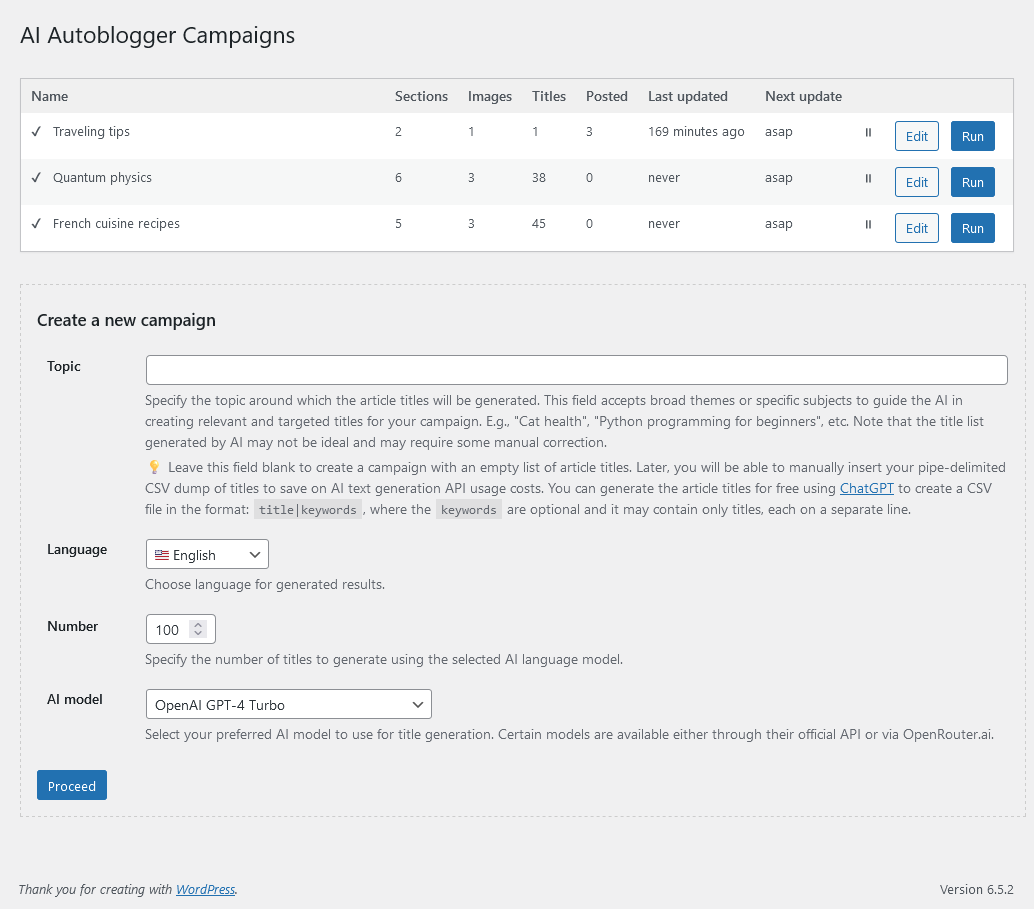
In the main interface of the plugin you will find a list of your article campaigns, their status and buttons for editing and manual initiation, which is always recommended before switching to automatic mode.
Below the list of campaigns there is a menu for creating a new article campaign. You can create it together with a list of article titles that will be generated by the selected AI model, or you can generate the list of titles yourself, for example using ChatGPT, to insert it manually into the campaign settings.
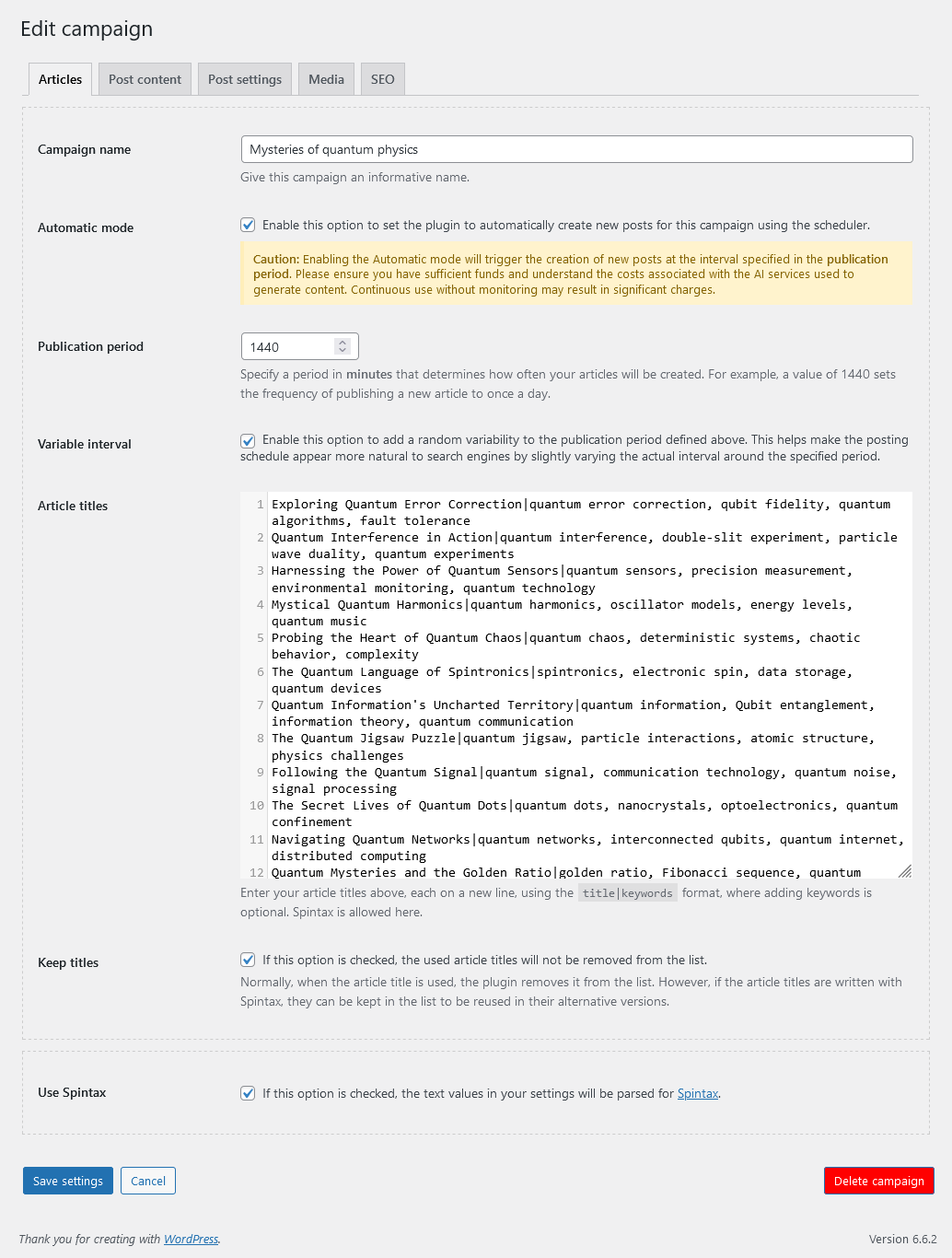
In this text field, you can edit your list of titles for the articles to be generated. Each entry follows a CSV-like, pipe-delimited format:
title|keywords|custom data|...
The format begins with title, which is a mandatory component. The second element, keywords, is optional and can contain a comma-separated list of keywords. Following that, you can add any number of custom data elements, which can be used for various purposes within your plugin settings.
For example, a valid entry might look like:
My Awesome Article Title|keyword1, keyword2|tag 1, tag 2|HTML code to be placed below the article|unique image style
Each element in a line is accessible as placeholders in different text fields of the plugin settings. These placeholders follow the format %%csv_fieldN%%, where N is the index of the element, starting from 0. Here’s how the placeholders are mapped:
%%csv_field0%%: Always contains the title.%%csv_field1%%: Contains keywords, if provided.%%csv_field2%%,%%csv_field3%%, and so on: Represent the additional custom data fields.
These placeholders can be used in fields like text generation prompts and image generation prompts, wherever you see the description “Spintax and CSV placeholders are allowed here.” This makes it possible to integrate your custom data into your automated content creation workflow.
The “Article Titles” text field supports Spintax, allowing you to generate multiple random titles from a single template.
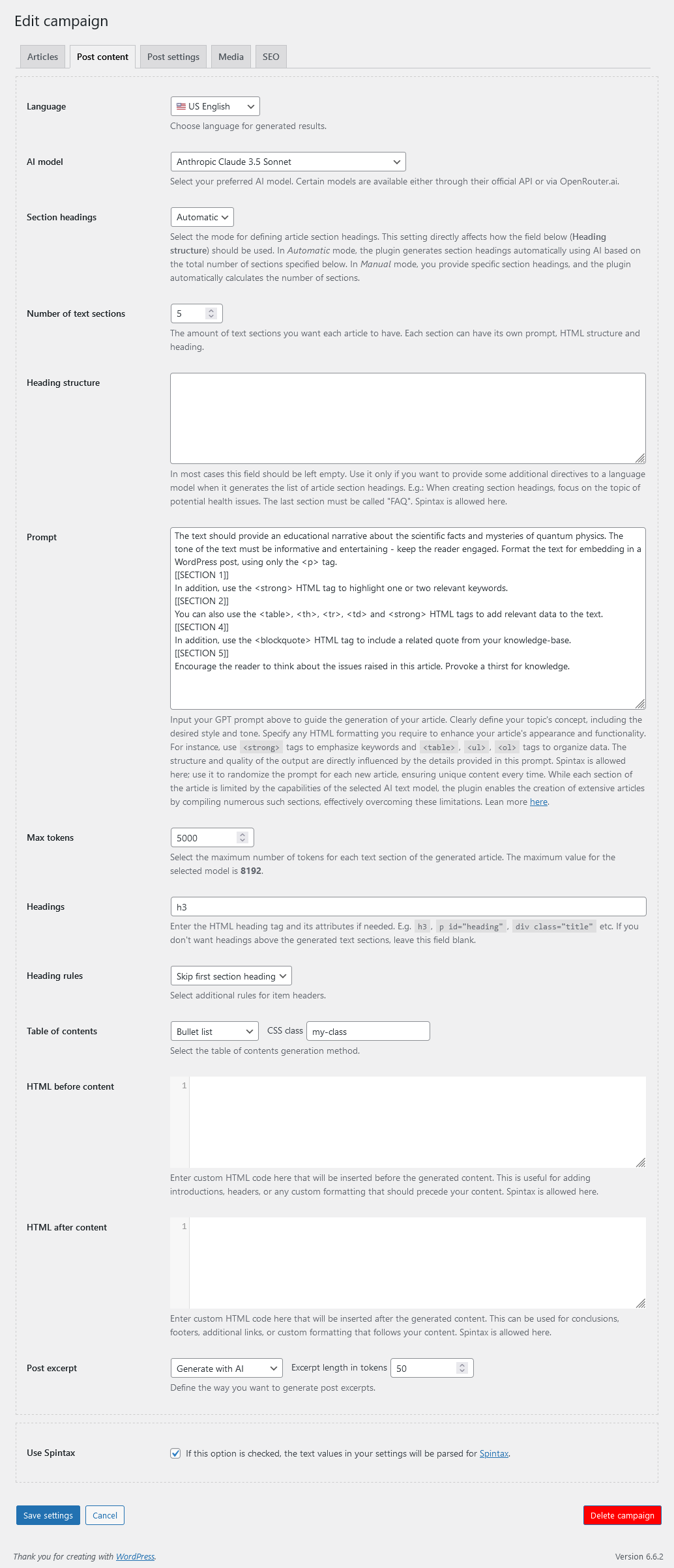
This tab allows you to configure the most important element-your prompt for the Text AI model-as well as other parameters for the generated articles. Note that the articles you create will consist of text sections, each of which will not exceed the maximum number of tokens generated by your chosen model (4,000-8,000 tokens per section).
Unfortunately, today’s models don’t generate long texts in one go, but don’t worry. Each of your articles can contain dozens of such sections and be comparable in size to an entire book. AI Autoblogger also ensures that the entire text of the article is coherent, not just a series of unrelated blocks of text. Thanks to a special algorithm in the plugin, your articles will always be coherent and complete.
You can also set up the generation of headings for text sections, determine how the post excerpt should be generated (use the text from the beginning of the article, generate a unique one using AI, or not generate it at all), and specify HTML code that will be automatically inserted at the beginning and end of each generated article. To insert HTML blocks with random content, use Spintax. This allows the content to vary each time an article is generated, ensuring that unique and dynamic sections are included in your posts.
Pay special attention to your prompt. This is where you will instruct the AI model on the topic and style of the articles for this campaign, as well as the HTML structure they should have. For example, if you want to include tables in the text, clearly indicate in the prompt that the model can generate them using <table>, <tr>, and <td> tags. If you plan to generate instructional articles on programming that will contain code, provide in your prompt an example of a <div> setup so that your WP theme or a specialized plugin like Enlighter can display the code inserts with correct formatting and syntax highlighting.
When setting up prompts for AI Autoblogger, you have the flexibility to use both simple and compound formats. A simple prompt can consist of general instructions for generating all sections of an article. However, a composite prompt allows for more detailed customization for individual sections.
Main prompt
This is used by the AI model to generate a list of section headings and to generate text for each section of the article.
Section-specific prompts
These are identified by markers such as [[SECTION 2]] followed by a prompt specific to that section. The section number indicates which section the additional prompt applies to. For example:
main prompt for all sections [[SECTION 2]] section 2 prompt [[SECTION 5]] section 5 prompt
The section-specific prompts are appended to the main prompt when the text for that article section is generated. These prompts can be added in any order, and their number can be less than or equal to the number of sections. If the number exceeds the number of sections, the plugin will simply ignore the extra section prompts. This system allows you to specify unique prompts for certain sections to refine the writing style, provide specific content directives, or assign a unique HTML structure to each section.
This approach ensures that each section can be tailored to meet specific content and style requirements, improving the overall coherence and relevance of your article.
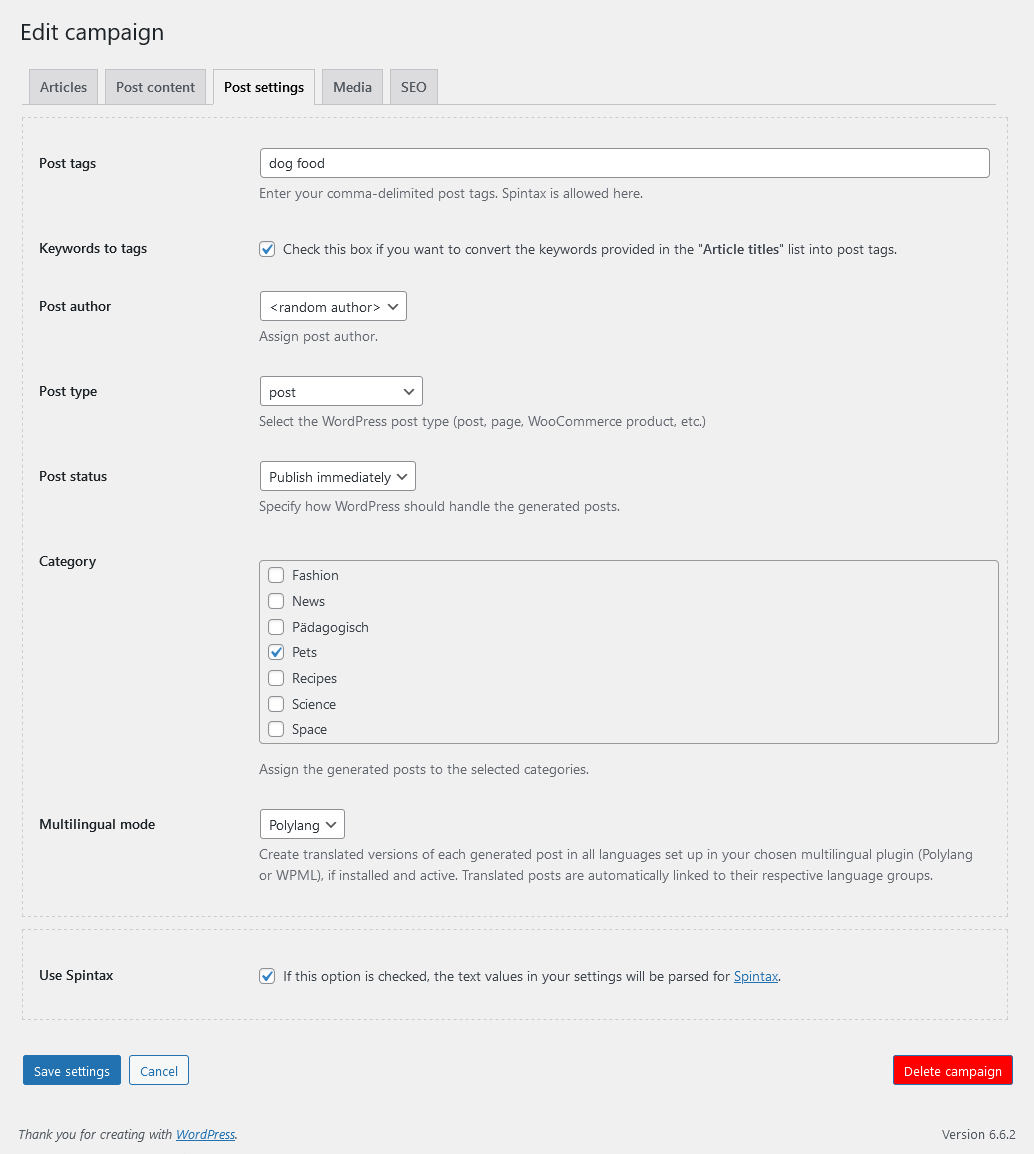
This tab allows you to set the main parameters for publishing the generated WordPress posts. These include tags, categories, and authors (you have the option to select a random author if your blog has multiple contributors). In addition, you can set the publishing status and type, such as “post”, “page”, or any registered custom post type. This allows you to tailor the publishing process to the specific needs and structure of your WordPress site.
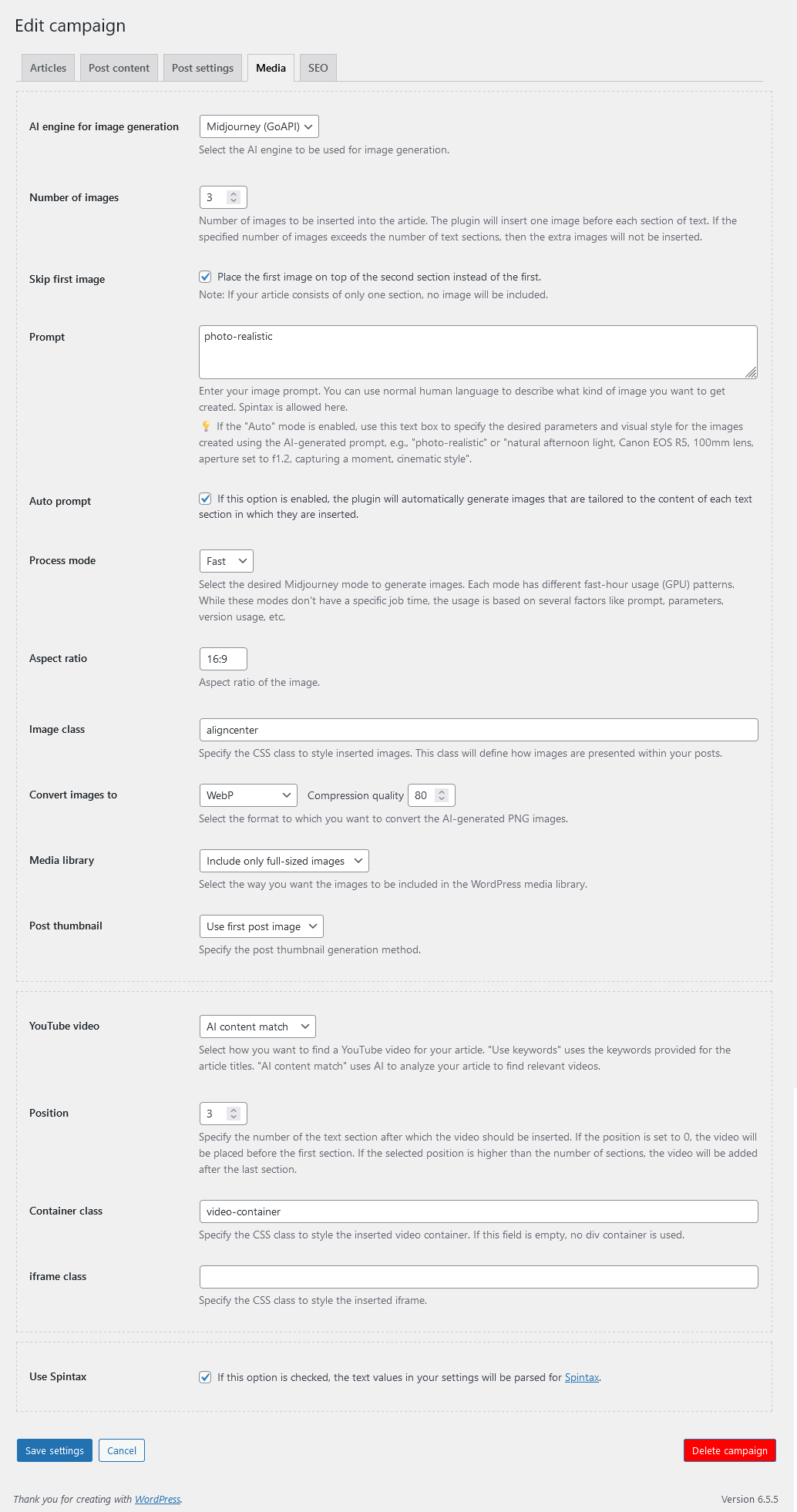
On the “Media” tab, you can select one of the three AI models supported by the plugin for image generation: Midjourney (recommended), Stable Diffusion, or DALL·E. Set the number of images the plugin will insert into each article above the generated text sections. You can also set the rules for generating the post thumbnail – use the first image from the article, generate a unique thumbnail, or choose not to generate a post thumbnail at all.
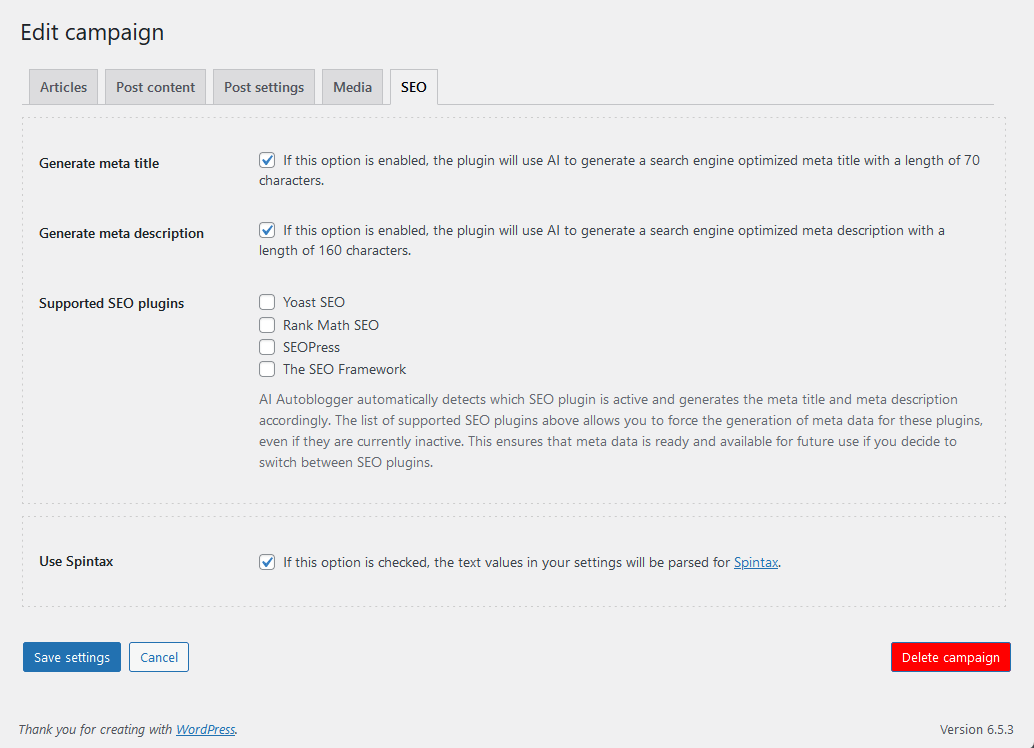
Note that you can use Spintax in the image generation prompt box. Additionally, if you check the “Auto prompt” box, the plugin will use AI to analyze the text of each section in the article to create the most appropriate prompt for generating an image. In this case, your own text prompt will serve as an extension, allowing you to specify a certain style, mood, etc. for the images. This is a powerful feature that, especially when combined with Midjourney, can automatically generate stunning illustrations for articles on any topic. The “Auto prompt” feature is unique for the AI Autoblogger plugin.
System requirements
AI Autoblogger is not particularly demanding on server resources and is designed for standard configurations typically provided by commercial hosting providers. However, before purchasing the plugin, please ensure that the following necessary components are available:
- WordPress 6 or greater.
- PHP ver. 7 or greater (PHP 7.4.32 and PHP 8 or greater are recommended).
- A live web site with a domain name. The plugin can’t be activated at unnamed IP address or at localhost.
What’s included?
The AI Autoblogger plugin distribution consists of a single PHP file that cannot be detected by search bots or any other methods. Attempting to open the plugin file in a browser will result in a system error – 404 page not found. The AI Autoblogger core code is the most compact among popular content aggregator plugins for WordPress, with a size of less than 500 kilobytes. The entire code is proprietary and does not contain any third-party GPL libraries, fragments, or components. When purchasing AI Autoblogger, you will receive the following:
- The AI Autoblogger plugin.
- Free email support.
- Free access to the support forum.
- Free updates for the duration of the product’s availability.
Choose your plan
1 site license
10 site license
100 site license
Instant Download
Upon completing your purchase, you will gain immediate access to the download link for the plugin. This means that right after your payment is processed and confirmed, you’ll be able to start downloading the plugin right away. No waiting time involved!
Please note that the download link and activation instructions will be sent to the email address associated with your purchase. In case you don’t receive the email promptly, we recommend checking your spam or junk folder. If you find the email there, please mark it as “not spam” to ensure future correspondence lands in your inbox.
Free Support and Free Updates
Purchase a license for the current version of AI Autoblogger and receive complimentary personal support as well as access to all subsequent updates for the duration of the product’s availability.
